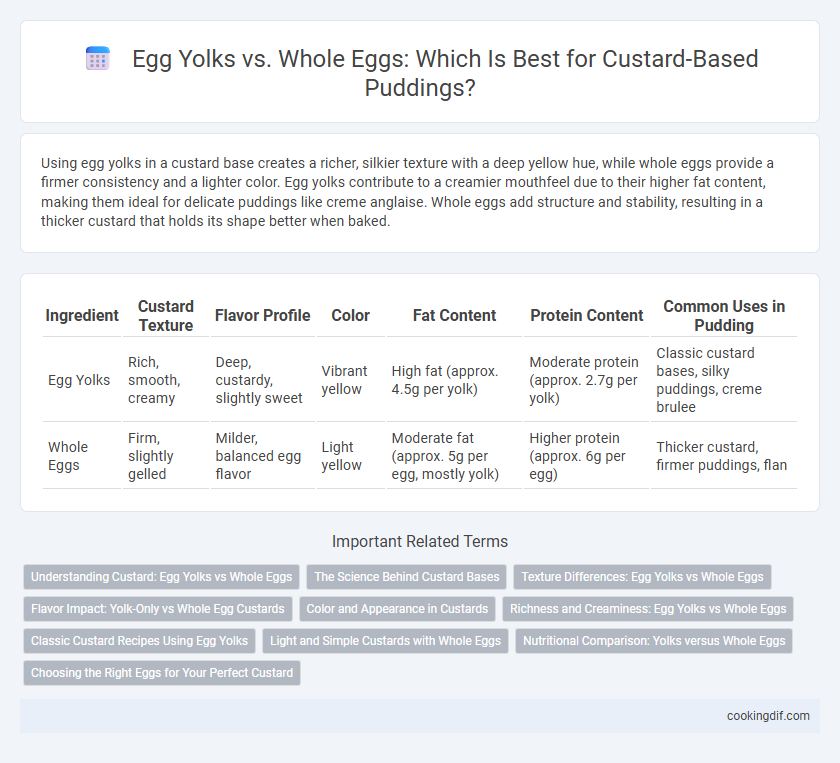Using egg yolks in a custard base creates a richer, silkier texture with a deep yellow hue, while whole eggs provide a firmer consistency and a lighter color. Egg yolks contribute to a creamier mouthfeel due to their higher fat content, making them ideal for delicate puddings like creme anglaise. Whole eggs add structure and stability, resulting in a thicker custard that holds its shape better when baked.
Table of Comparison
| Ingredient | Custard Texture | Flavor Profile | Color | Fat Content | Protein Content | Common Uses in Pudding |
|---|---|---|---|---|---|---|
| Egg Yolks | Rich, smooth, creamy | Deep, custardy, slightly sweet | Vibrant yellow | High fat (approx. 4.5g per yolk) | Moderate protein (approx. 2.7g per yolk) | Classic custard bases, silky puddings, creme brulee |
| Whole Eggs | Firm, slightly gelled | Milder, balanced egg flavor | Light yellow | Moderate fat (approx. 5g per egg, mostly yolk) | Higher protein (approx. 6g per egg) | Thicker custard, firmer puddings, flan |
Understanding Custard: Egg Yolks vs Whole Eggs
Egg yolks create a richer, creamier custard base due to their high fat content, contributing to a smooth, velvety texture essential for traditional pudding. Whole eggs offer a firmer, more stable custard structure as the egg whites provide additional protein that coagulates during cooking, resulting in a custard that holds its shape well. Understanding the balance between egg yolks and whole eggs is crucial for achieving the desired consistency and flavor in custard-based puddings.
The Science Behind Custard Bases
Egg yolks contain a higher concentration of proteins and fats that act as natural emulsifiers, providing a rich, creamy texture essential for stable custards. Whole eggs introduce additional water and proteins which can lead to a firmer, more gelatinous custard but may risk over-coagulation if not carefully controlled. The balance between yolk and whole egg proteins directly influences the custard's viscosity, curdling point, and final mouthfeel.
Texture Differences: Egg Yolks vs Whole Eggs
Egg yolks create a rich, velvety texture in custard bases due to their high fat content and emulsifying properties, resulting in a smooth and creamy pudding. Whole eggs provide a firmer, more set texture because the egg whites contribute additional protein that tightens the custard structure during cooking. Choosing egg yolks yields a silkier mouthfeel, while whole eggs produce a denser and more custard-like consistency.
Flavor Impact: Yolk-Only vs Whole Egg Custards
Egg yolk-based custards deliver a richer, creamier texture with a pronounced buttery flavor that enhances the dessert's indulgence. Whole egg custards, incorporating whites, yield a lighter, more delicate consistency with a subtler taste, balancing richness and fluffiness. The choice between yolk-only and whole egg bases significantly impacts the custard's depth of flavor and mouthfeel, catering to different palates and dessert styles.
Color and Appearance in Custards
Egg yolks contribute a rich, golden-yellow color to custard bases, enhancing their visual appeal and giving puddings a creamy and luxurious appearance. Whole eggs yield a paler, less vibrant custard due to the diluted pigment from the egg whites, resulting in a more opaque and less glossy texture. Using egg yolks alone intensifies the color and smoothness, making the custard look more appetizing and professionally crafted.
Richness and Creaminess: Egg Yolks vs Whole Eggs
Egg yolks contribute significantly more richness and creaminess to custard bases compared to whole eggs, due to their higher fat content and emulsifying properties. Whole eggs provide a lighter texture but can result in a less velvety finish, as the whites add protein without the same level of fat. For a custard pudding that prioritizes smoothness and indulgence, egg yolks are the preferred choice to achieve a luscious, thick consistency.
Classic Custard Recipes Using Egg Yolks
Classic custard recipes prioritize egg yolks for their rich texture and creamy consistency, creating a velvety pudding base that whole eggs cannot replicate. The higher fat content in yolks enhances flavor depth and results in a smoother custard by reducing the coagulation rate compared to whole eggs. Using solely egg yolks is essential for achieving the luxurious mouthfeel characteristic of traditional custards like creme brulee and custard tarts.
Light and Simple Custards with Whole Eggs
Whole eggs in custard bases create a lighter and simpler texture compared to using egg yolks alone, as the whites contribute to a more airy and delicate consistency. The protein structure in whole eggs helps set the custard without making it overly dense or rich, ideal for smooth puddings with balanced flavor. This method enhances creaminess while maintaining an easy-to-prepare custard that holds well without browning prematurely during baking.
Nutritional Comparison: Yolks versus Whole Eggs
Egg yolks provide a rich source of essential nutrients such as vitamin A, vitamin D, and healthy fats, contributing to creamier custards, while whole eggs offer a more balanced nutritional profile with added protein and fewer calories. Using whole eggs in a custard base increases the protein content and reduces cholesterol per serving, appealing to those seeking heart-healthy options. Nutritional differences between yolks and whole eggs influence texture and dietary considerations when selecting ingredients for pudding recipes.
Choosing the Right Eggs for Your Perfect Custard
Egg yolks provide a rich, creamy texture and a deep custard flavor, making them ideal for silky pudding bases, whereas whole eggs contribute firmness and structure but can result in a denser custard. For a smooth and luscious custard, using only egg yolks enhances creaminess without overpowering the sweetness or creaminess of the dairy. Balancing the number of yolks with the liquid ratio ensures the perfect custard consistency and prevents curdling or over-thickening.
Egg yolks vs Whole eggs for custard base Infographic

 cookingdif.com
cookingdif.com